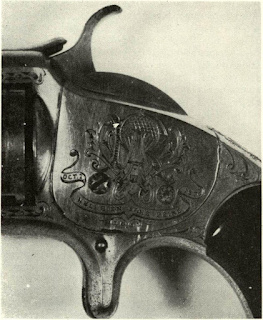It is the habit of the Ordnance Department to automatically classify any goods as “unserviceable” after
The arms sales were widely advertised, and held at
Another firm which grew to prominence in later
Even at this present time it is possible to obtain new
that he bought from yet another merchant. He selected
The sale lists of would send a modem collector
Four days before the sale, the Government suspended
They reappraised the conditions of such sales, and a
Three offerings were sufficiently varied to be of
at Houston & Greene streets (PO Box ) in New
100.000 Springfield rifled muskets, caliber .58,
new
100.000 Springfield rifled muskets, caliber .58,
cleaned and repaired
5.000 Spencer carbines, new model, caliber .50,
new
5.000 Spencer carbines, old model, caliber .52,
new
5.000 Spencer carbines, accouterments,
“Blakesley’s,” new
5.000 Spencer carbines, accouterments “other
models,” new
The second offering by Colonel Crispin on November 22, , was to be opened as to bids on December 22, . It included:
40.000 Enfield rifle muskets, cal. .577, new
3.000 United States flintlock muskets, cal. .69,
serviceable
5.000 Remington carbines, cal. .44, new
15.000 Starr’s army pistols, cal. .44, new
There were also sabers and many thousands of
On October 17, , a further offer was made
2.500 breech-loading muskets, caliber .58, with
cartridges for same.
1.000 Ball’s repeating carbines, cal. .50, with
ammunition.
2.500 Gallagher’s carbines, adapted for Spencer
ammunition.
4.000 Maynard’s carbines, with 400 rounds of
ammunition per gun.
1.000 Palmer’s carbines, caliber .44, with
ammunition.
3,600 Remington carbines, caliber .44, with
2.500 Warner’s carbines and ammunition.
2,700 Joslyn’s carbines & ammunition, caliber .52.
40.000 sets carbines accouterments, serviceable,
Blakesley’s and other patterns.
70.000 sets infantry accouterments.
20.000 Starr’s revolvers, caliber .44, with
ammunition.
5.000 Rogers & Spencer’s revolvers, with
ammunition, caliber .44.
10.000 Remington Army revolvers, caliber .44,
with ammunition.
35.000 pistol holsters.
40.000 cavalry sabers.
1.000 Spencer rifles.
20.000 sets horse equipments.
Remington was a heavy buyer in October, , purchasing 50,000 Springfield rifled muskets, cleaned and
Spencer carbines were a heavy favorite among the
In selling surplus, the custom of the Government
Unable to control the newspapers, the Remingtons
The arms sales were widely advertised, and held at
Another firm which grew to prominence in later
Even at this present time it is possible to obtain new
that he bought from yet another merchant. He selected
The sale lists of would send a modem collector
Four days before the sale, the Government suspended
They reappraised the conditions of such sales, and a
Three offerings were sufficiently varied to be of
at Houston & Greene streets (PO Box ) in New
100.000 Springfield rifled muskets, caliber .58,
new
100.000 Springfield rifled muskets, caliber .58,
cleaned and repaired
5.000 Spencer carbines, new model, caliber .50,
new
5.000 Spencer carbines, old model, caliber .52,
new
5.000 Spencer carbines, accouterments,
“Blakesley’s,” new
5.000 Spencer carbines, accouterments “other
models,” new
The second offering by Colonel Crispin on November 22, , was to be opened as to bids on December 22, . It included:
40.000 Enfield rifle muskets, cal. .577, new
3.000 United States flintlock muskets, cal. .69,
serviceable
5.000 Remington carbines, cal. .44, new
15.000 Starr’s army pistols, cal. .44, new
There were also sabers and many thousands of
On October 17, , a further offer was made
2.500 breech-loading muskets, caliber .58, with
cartridges for same.
1.000 Ball’s repeating carbines, cal. .50, with
ammunition.
2.500 Gallagher’s carbines, adapted for Spencer
ammunition.
4.000 Maynard’s carbines, with 400 rounds of
ammunition per gun.
1.000 Palmer’s carbines, caliber .44, with
ammunition.
3,600 Remington carbines, caliber .44, with
2.500 Warner’s carbines and ammunition.
2,700 Joslyn’s carbines & ammunition, caliber .52.
40.000 sets carbines accouterments, serviceable,
Blakesley’s and other patterns.
70.000 sets infantry accouterments.
20.000 Starr’s revolvers, caliber .44, with
ammunition.
5.000 Rogers & Spencer’s revolvers, with
ammunition, caliber .44.
10.000 Remington Army revolvers, caliber .44,
with ammunition.
35.000 pistol holsters.
40.000 cavalry sabers.
1.000 Spencer rifles.
20.000 sets horse equipments.
Remington was a heavy buyer in October, , purchasing 50,000 Springfield rifled muskets, cleaned and
Spencer carbines were a heavy favorite among the
In selling surplus, the custom of the Government
Unable to control the newspapers, the Remingtons


Comments
Post a Comment